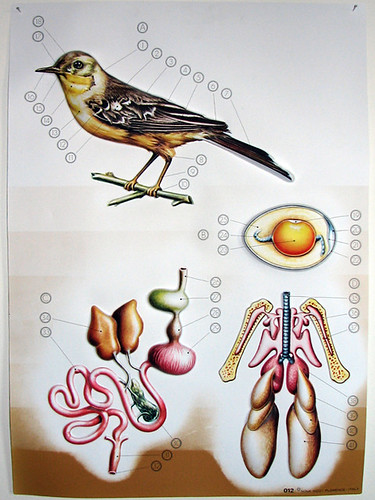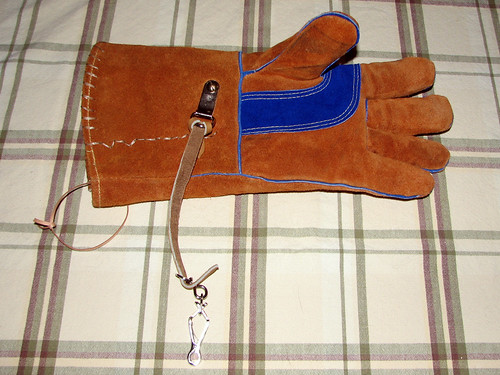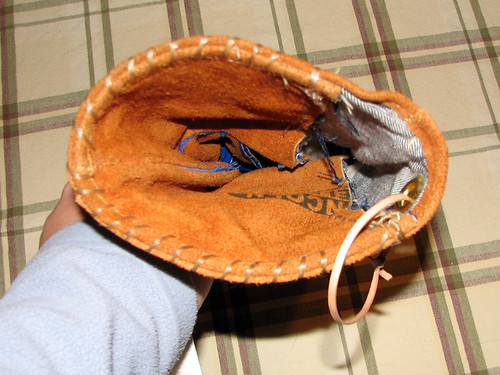This blog is the currently featured over at the Nature Blog Network. Read all about it!
Hey, I’m a winner!
My short bird story was chosen for this month’s First Friday Fiction Contest over at WildBird on the Fly. I just realized this regular contest should be included in my monthly contest roundup post. It was not omitted on purpose, honestly! You can read my story here.
Raptor Internship Week 4
The focus during the fourth week of the Raptor Internship at Flint Creek was more handling (following basics, equipment, and handling part one).
After a brief review of what we learned last week, we practiced putting equipment on a bird by using only our dominant hand. Dawn devised a contraption made of Velcro strips and pencils (kestrel) or markers (hawk) to simulate a bird’s legs. Using this, we were able to thread anklets with jesses, attach leash extenders to jesses, and thread leashes to leash extenders. Boy, was it great to practice in this way. We worked in small groups and could help each other remember to keep our “bird” level and secure while we worked. Dawn told us she first learned to apply and remove equipment like this with a Red-tailed Hawk on the glove. Wow! (Many thanks to my classmate Lee for taking the video and photos below)
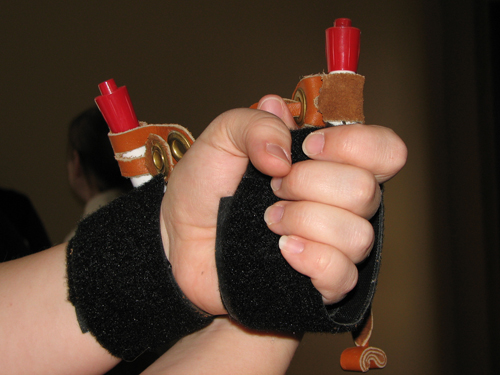
Working from behind, here a jess is being threaded through one of the “hawk’s” anklets
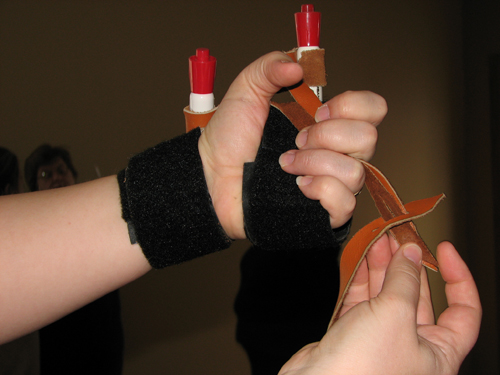
Here the jesses are being inserted into the slit of the leash extender.
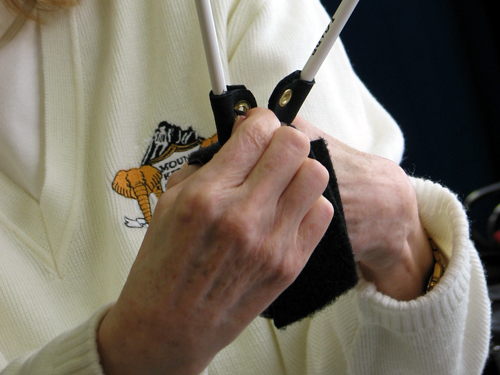
Working a jess into one of the “kestrel’s” anklets
After everyone got to practice with both sets of equipment, Dawn showed us how to tie a falconer’s knot. After observing Dawn several times, we all took turns trying it out. I had a really hard time seeing what Dawn was doing exactly with her fingers and the leash, but once it was my turn I picked it up pretty quickly. Here’s what it looks like:
The piece of leash between the metal loop and the leash extender should be shorter – I need to practice that!
After lunch and another brief lecture about special handling situations, it was time for us to work with a bird once again. This time Pip, a Barn Owl, was bought in and placed on a low perch. Pip’s parents were part of a captive breeding program for Illinois. While his siblings were released, Pip was held back to be used as an education bird. He is fully flighted.
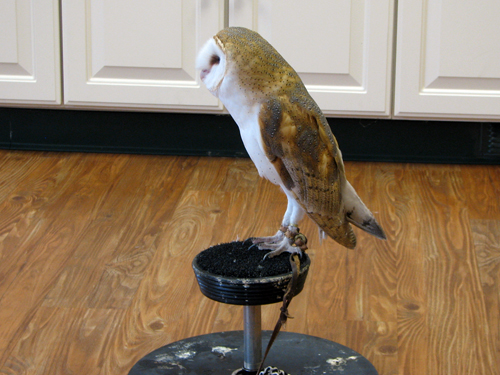
We took turns taking Pip onto our glove and (much to our initial horror) removing all of his equipment except for one jess. Pip was so relaxed he was mostly either preening (it was so very cool to hear him ‘zip’ his feathers so close!) or near sleeping as we worked on the equipment.
I think we all did really well with this exercise. The ability to practice with the Velcro birds really helped prepare us all for working with Pip on the glove.
It was another great class – I’m so glad I signed up for this internship! Next week we’ll look at the natural history of diurnal raptors and get more handling experience. I can’t wait!
Doodads from a weird & wonderful store
Last month we visited the fabulous and strange American Science & Surplus shop in Chicago. My dad used to take me to this oddball store when I was younger and I remember what fun it was for a curious kid to look through aisle after musty aisle of peculiar containers, mysterious military gear, unidentifiable tools and other baffling and strange things.
Among the treasures found on this last visit were some bird-themed goodies, natch.
This bird anatomy poster was made by Nova Rico of Florence Italy. I can’t find any information about it online as the company seems to specialize in globes now. The bird, organs and egg are all slightly raised. I’m not sure what kind of bird it is. It didn’t come with the key so I’m going to have some fun making that.
There were three different Fun Bendies Birdsticks to choose from. I rejected the purple pelican and green parrot for this blue toucan. It’s got a loop on the head for hanging but also comes on a long bendy stick. To hang or to stick, that is the question. The tag informs there are three other series of Fun Bendies: Flowersticks, Sticky Bugs, and Fishsticks.

Next I picked up two Endangered Species Reusable Stickers: Whooping Crane and California Condor. The condor one doesn’t ‘work’ anymore since the skeleton shows up in broad daylight. “Beautiful full color animals by day, glow in the dark skeletons by night!” How creepy is this?
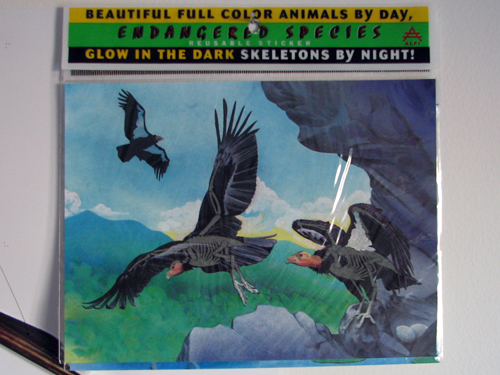
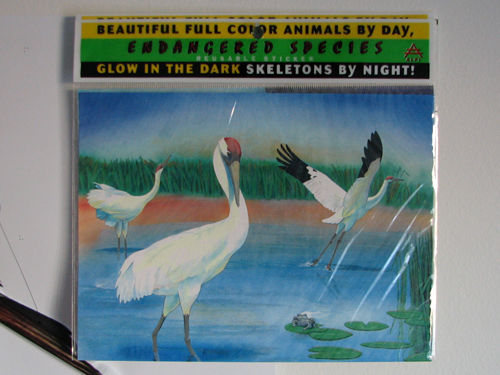
You’re probably familiar with this woodpecker friction toy I picked up. I hadn’t seen one in years. Minutes of fun, I tell you.
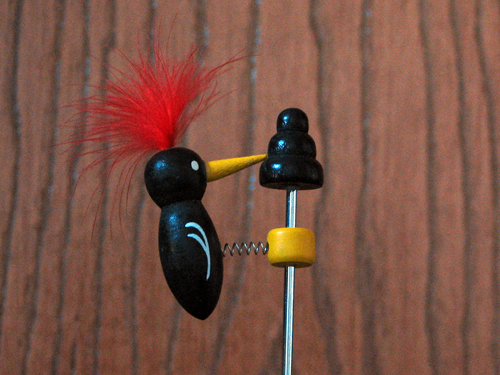
Raptor Internship Week 3
Last Tuesday morning during my drive to Flint Creek Wildlife Rehabilitation I saw two American Kestrels. One was diving from a utility wire down to the ground; the other was perched and bobbing its tale as kestrels will do. Little did I know then that later in the day I would hold my first bird on the glove, and it would be a beautiful American Kestrel.
Our instructor, Dawn, brought a carrier into Flint Creek as the class participants were arriving. The patient in the carrier was Phoenix, a remarkable bird that we would later get to see being treated.
The focus for the third week of the Raptor Internship was handling techniques (we earlier covered basics and equipment). We began with a lecture and viewing photos of the basics of proper raptor handling. There is a lot to keep in mind when handling a bird, and all of the proper techniques are practiced in order to keep both the handler and the bird safe at all times.
After the lecture, Flint Creek’s beautiful American Kestrel Darwin was brought into the classroom.

Darwin’s information sign outside his mew at Flint Creek Wildlife Rehabilitation
Dawn demonstrated taking the tethered bird from perch to glove. Then each student took a turn doing the same. We were each able to spend several minutes with him on our glove. Dawn had to talk us through each step but I think we all did very well. I know the other ladies in the class all looked like naturals once Darwin was in place. I was so nervous when it was my turn but both Dawn and Darwin were so patient. It was hard to take my eyes off of him when Darwin was perched on my glove – I was awestruck!
Once the handling practice was over, it was close to noon, which meant it was time for Dawn to take care of Phoenix once again. We got to watch Dawn and her patient through the clinic’s one-way glass as Dawn administered medicine to Phoenix and fed her. I was so moved not only by this exceptional bird’s will to live, but by Dawn’s extreme professionalism in handling the bird. This beautiful bird has a long road ahead in her recovery. Please consider donating to Flint Creek Wildlife Rehabilitation for all of the remarkable work they do.
After lunch the rest of the class time was spent finishing our gloves from the last class and making equipment. We cut jesses, leash extenders and anklets from practice leather. Later I helped condition a few leather jesses in jess grease (kind of messy!) and even got to cut a few jesses using kangaroo leather.

Practice leash extenders, jesses and anklets (left to right)
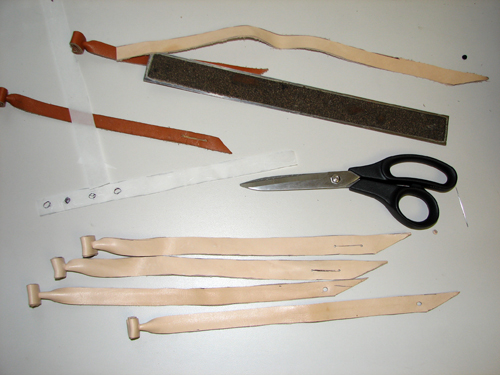
Jesses made from kangaroo leather
Next class: Handling Part 2!
Phoenix’s amazing story
Flint Creek Wildlife Rehabilitation has been getting a lot of publicity the last couple of days from a remarkable patient who was brought in last Saturday. The fire from a small plane crash in Sugar Grove IL had an unexpected victim – a Red-tailed Hawk. The bird was found lying on the ground near the crash sight, badly burned. She was brought to Flint Creek by Kane County Animal Control and since then she has been receiving around the clock care. Here is a piece that aired on our local PBS channel last night.
See also: The burnt bird… | Hawk healing after Sugar Grove plane crash | Badly burned hawk is ‘miracle’ plane crash survivor
I’m going to write a bit about the third week of the raptor internship in a bit. We were lucky to be able to watch Dawn care for this remarkable bird, who is being called Phoenix.
The Big Year coming to theaters?!
This interesting tidbit came to my attention via Facebook: a film adaptation of Mark Obmascik’s The Big Year is in development. According to this page on the New York Times, the cast includes Dustin Hoffman, Owen Wilson and Jack Black. The director is listed as David Frankel, and the genre is listed as adaptation, comedy and period (the story takes place in 1998). According to IMDbPro, the production companies are Deuce Three Productions and DreamWorks SKG, with Carol Fenelon and Curtis Hanson on board to produce.
I read The Big Year a few months ago and I thought it would make a great movie. The casting has me a bit puzzled, though.
**mild spoilers ahead for anyone who hasn’t read the book **
** here come the spoilers **
The book covers the competition between three birders attempting a North American Big Year – they’re trying to see the most bird species in the continental United States and Canada. The year is 1998 and the three players are Sandy Komito, Al Levantin and Greg Miller.
I figure Sandy Komito was about 66 years old during The Big Year. He had worked as a salesman, and was known in the birding community as “the loud wisecracker from New Jersey.” Reading the book, I pictured him as looking something like Dan Hedaya. I would guess Dustin Hoffman would be cast as Komito. There’s a photo of Komito towards the bottom of this page, but I can’t figure out when it was taken (1997?).
At the start of the big year, Greg Miller was working systems for a nuclear power plant, getting ready for Y2K. He was recently divorced, overweight, and sad. “Forty years old and alone and no children-he hadn’t pictured his life this way.” It’s not at all hard for me to picture Jack Black in this role. There’s a photo of Greg Miller about a quarter of the way down this page, which was apparently taken around 2004.
In 1998, Levantin was a business executive recently retired after a 40-year career. As Obmascik describes him, “He was sixty-six years old, but often accused of lying about his age. With an outdoorsy pink in his cheeks, slate-blue eyes, and shoulders that still packed some muscle, he looked fifty. He acted thirty. He had charisma.” In my mind he looks kind of like Alan Dale.
So of those three main characters, I’m trying to figure out where Owen Wilson fits in. Could he play the part of narrator, or of Mark Obmascik, the book’s author? Obmascik doesn’t actually follow the birders around during 1998, but maybe the screenplay will work that way. What do you think? Have you read The Big Year? Who would you cast as the three leads? Are there any other roles – Kenn Kaufman, Debra Shearwater, etc – you would like to see cast a certain way?
Kestrel catches supper
Earlier this week we took a short walk at Rollins Savanna. It was cold, but the sun was shining (at least when we started our walk) and it was nice to get some fresh air. We saw something pretty neat. I don’t have great photos of what we saw, but I wanted to share it anyway. 🙂
Walking on the Education Trail Loop on the south side of the preserve, we noticed a falcon fly across our view. It landed in a tree far ahead of us on the trail. We approached slowly and stopped to look through our binoculars. An American Kestrel!
Suddenly the bird dropped to the ground, out of view behind snow-covered reeds. I didn’t realize it until I looked at my photos later, but I captured the bird on its dive down to the ground. It’s in the lower right corner of the shot.
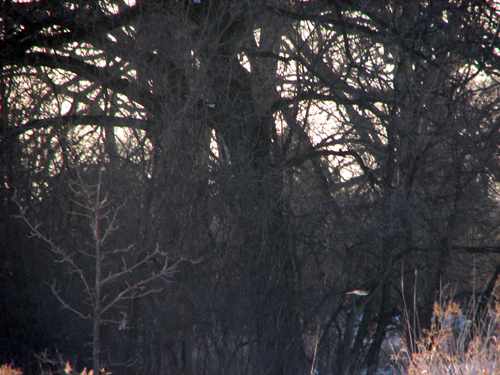
And then, not a minute later, the bird rose up, with a mouse in its talons. Wow!
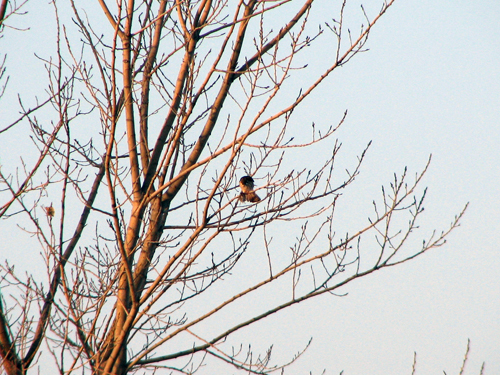
It landed in a far away tree and ate its supper. We stood far away, but we could see pretty well through our bins. It was so neat to see!
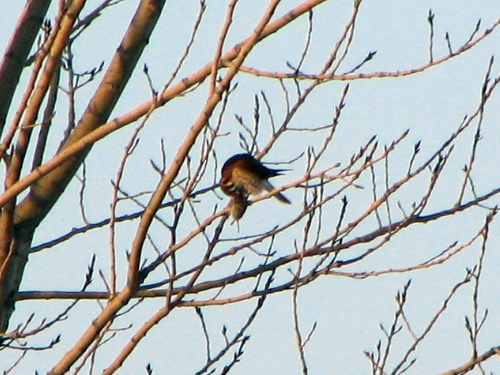
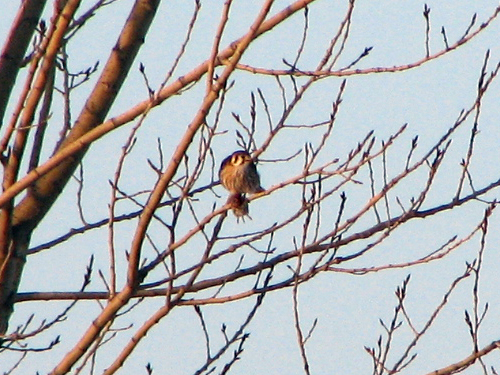
Good birding despite missing birds
Yesterday we joined another area bird club on a field trip. The Kane County Audubon Roadside Birding outing started at Peck Farm in Geneva. There we picked up a passenger, who just happened to be club president Bob Adrini. Since we hadn’t been birding in Kane County before, it was great to learn about the area specialties and birding spots from Bob. The conversation was engaging even though the birds didn’t cooperate. Our targets for the day were Snow Buntings, Lapland Longspurs and Horned Larks. We only got the larks.
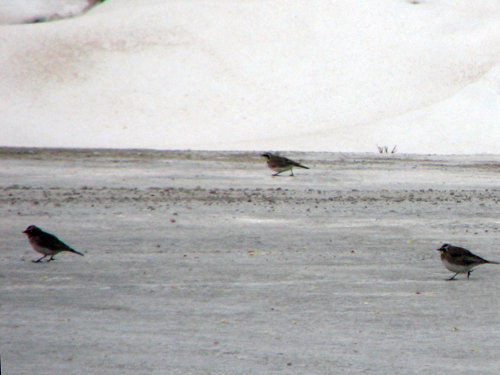
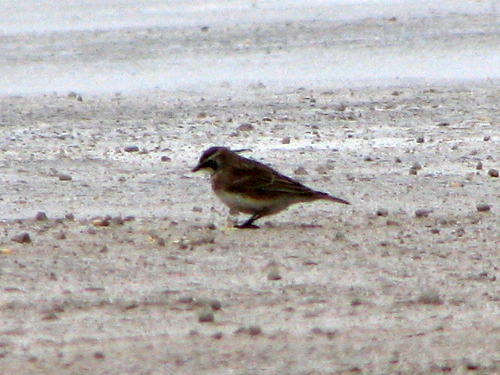
We saw the larks in the parking lot of a grain mill. In the back of the mill’s lot there was a huge pile of corn. A large group of Rock Pigeons and Brown-headed Cowbirds congregated on the ground next to the pile, but these two Mourning Doves went right to the source.
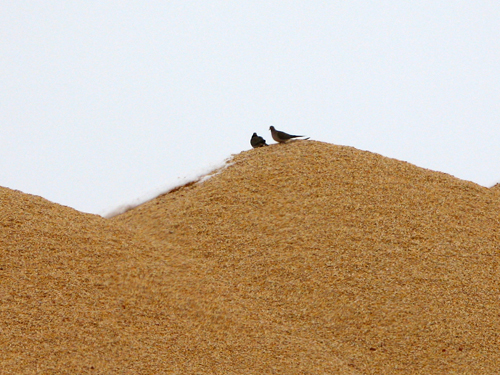
Though we did see quite a few roadside Red-tailed Hawks during the drive, it wasn’t until the end of the day that we saw a pair, perched in a tree close to the parking lot where our journey began. In the same field we saw our first Northern Harrier of the day. Despite the bad luck with the birds, the miserable weather and frigid temperatures, we had a good birding day. Many thanks to Bob for the conversation!

Raptor Internship Week 2
I recently started a 12-week Raptor Internship at Flint Creek Wildlife Rehabilitation. The second class was this week; you can read about the first class here.
The focus of this week’s class was equipment. Prior to class we had to read the equipment chapter in our textbook, Raptors in Captivity. Most of the terminology and all of the mechanics were totally new to me, so I found it hard to visualize some things and how they attach to each other and to the bird. I didn’t even realize that some equipment stays on the bird more or less permanently.
During class Dawn showed us the various equipment, so the reading became clear as we could see and handle each thing. Different materials can be used for certain equipment (leather vs. nylon, etc), so that was discussed as well. Flint Creek has their own equipment preferences, but we are learning about the different possibilities that may be used at other facilities.
During the morning break I took this photo of the view from my table. I can see Meepy (the Barred Owl) from my seat, if she is sitting on my side of her mew. She’s perched just slightly left of center in this photo:
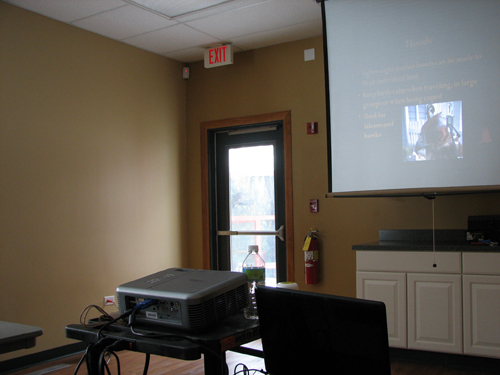
I walked up to the door and took a photo through the glass. She’s dozing.
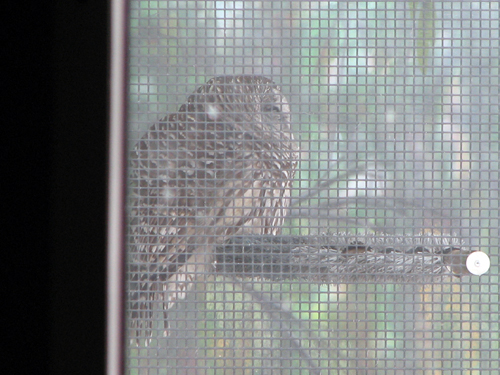
Here are a few of the different gloves that Dawn showed us. The one on the far left is a two-piece over-the-elbow glove used for eagles.

At the end of last week we had learned that we would be making our own gloves during the second class. We all wondered what that meant and I think a few of us guessed we would be cutting and stitching something out of a fresh sheet of leather. Oh, how wrong we were!
After the morning break on Tuesday Dawn passed out pairs of welding gloves. She explained how we would make our gloves and then we went to work.
First, the right-hand glove was cut in half, between the middle and ring fingers down the middle. The gloves are leather with a denim lining and a woolly synthetic (?) padding in the fingers, so this was tough. The half with the thumb, index and middle fingers was saved and the rest was discarded. The saved half was then turned inside out and stuffed inside the left glove. Inverting the glove was very difficult – there are three layers to work with and the outer leather layer was tough! We used pens or the blunt ends of tools to help push the fingers inside-out. This step was accomplished with much grunting and just a bit of unhappy mumbling.
Once the cut piece was inverted and stuffed into the left-hand glove, the result was a glove with a double-reinforced top half. The two pieces were next sewn together, which was accomplished using heavy waxed thread, thick needles, pliers, and much grunting, mumbling and cursing.
I was able to invert my half glove fairly quickly, so I was able to start sewing before anyone else. Pushing the needle through two layers of welding glove was nearly futile and when Dawn asked if I could use a pair of pliers, I didn’t hesitate to accept them. Using the pliers, I was able to finish my sewing before the rest of the class. In the end I was even able to add a leash tie and a grommet for a hip loop before class was over. I’m kind of afraid my aptitude at glove-making means I will be lacking in other areas of the class (it figures, right?). We shall see! Anyway, I’m very pleased with my glove and I’m glad I was able to finish before it was time to leave for the day.
I took this photo during our lunch break. By this time I was working on sewing the two pieces together up the middle. I broke my needle (pictured) so I had to wait for Dawn to return with more needles before continuing. We all broke a LOT of needles!
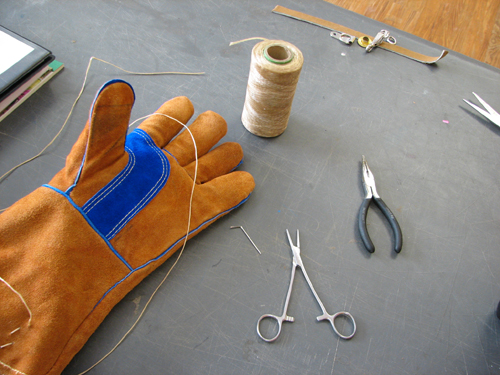
Here’s the finished glove (click to embiggen). That’s the leash tie below the palm. The thin piece of leather at the bottom of the glove, used to fix the glove to our belts via a keychain, is tied through a grommet.
This is what the inside of the glove looks like (click to embiggen). Here you can see how the half right-hand glove is inverted and stuffed inside.
Since much of our time this week was spent working on our gloves, the five of us in the class (the no-show dropped out) spent some time chatting. We have different goals for the class but we all share a love for nature and for these birds we are going to get to work with. And I think we now all share an aversion to sewing. 🙂



